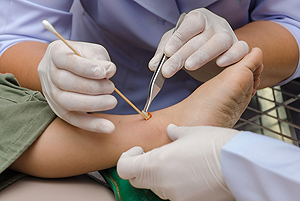 When the outer layers of the skin on the feet are damaged and expose deeper tissues, it is known as a foot wound or ulcer. These wounds can occur from issues such as wearing shoes that don’t fit correctly, as well as an injury or trauma to the feet. If these wounds are left untreated, they may become infected which could lead to other issues including amputation. Common indicators of an infection include inflammation, redness, an odor, or thickened tissues. Patients who are at a higher risk for foot wounds (such as diabetics, who may have trouble feeling the wounds) or who notice that their foot wound is not healing, should have the wound looked at by a podiatrist. Upon examination, a podiatrist will likely remove the unhealthy skin and then help determine the best treatment method for the particular wound, including shoe padding, antibiotics, or even surgery.
When the outer layers of the skin on the feet are damaged and expose deeper tissues, it is known as a foot wound or ulcer. These wounds can occur from issues such as wearing shoes that don’t fit correctly, as well as an injury or trauma to the feet. If these wounds are left untreated, they may become infected which could lead to other issues including amputation. Common indicators of an infection include inflammation, redness, an odor, or thickened tissues. Patients who are at a higher risk for foot wounds (such as diabetics, who may have trouble feeling the wounds) or who notice that their foot wound is not healing, should have the wound looked at by a podiatrist. Upon examination, a podiatrist will likely remove the unhealthy skin and then help determine the best treatment method for the particular wound, including shoe padding, antibiotics, or even surgery.
Wound care is an important part in dealing with diabetes. If you have diabetes and a foot wound or would like more information about wound care for diabetics, consult with one of our podiatrists from New York Foot and Ankle. Our doctors will assess your condition and provide you with quality foot and ankle treatment.
What Is Wound Care?
Wound care is the practice of taking proper care of a wound. This can range from the smallest to the largest of wounds. While everyone can benefit from proper wound care, it is much more important for diabetics. Diabetics often suffer from poor blood circulation which causes wounds to heal much slower than they would in a non-diabetic.
What Is the Importance of Wound Care?
While it may not seem apparent with small ulcers on the foot, for diabetics, any size ulcer can become infected. Diabetics often also suffer from neuropathy, or nerve loss. This means they might not even feel when they have an ulcer on their foot. If the wound becomes severely infected, amputation may be necessary. Therefore, it is of the upmost importance to properly care for any and all foot wounds.
How to Care for Wounds
The best way to care for foot wounds is to prevent them. For diabetics, this means daily inspections of the feet for any signs of abnormalities or ulcers. It is also recommended to see a podiatrist several times a year for a foot inspection. If you do have an ulcer, run the wound under water to clear dirt from the wound; then apply antibiotic ointment to the wound and cover with a bandage. Bandages should be changed daily and keeping pressure off the wound is smart. It is advised to see a podiatrist, who can keep an eye on it.
If you have any questions, please feel free to contact one of our offices located in Franklin Square, Bethpage, Brooklyn, and Massapequa, NY . We offer the newest diagnostic and treatment technologies for all your foot care needs.
